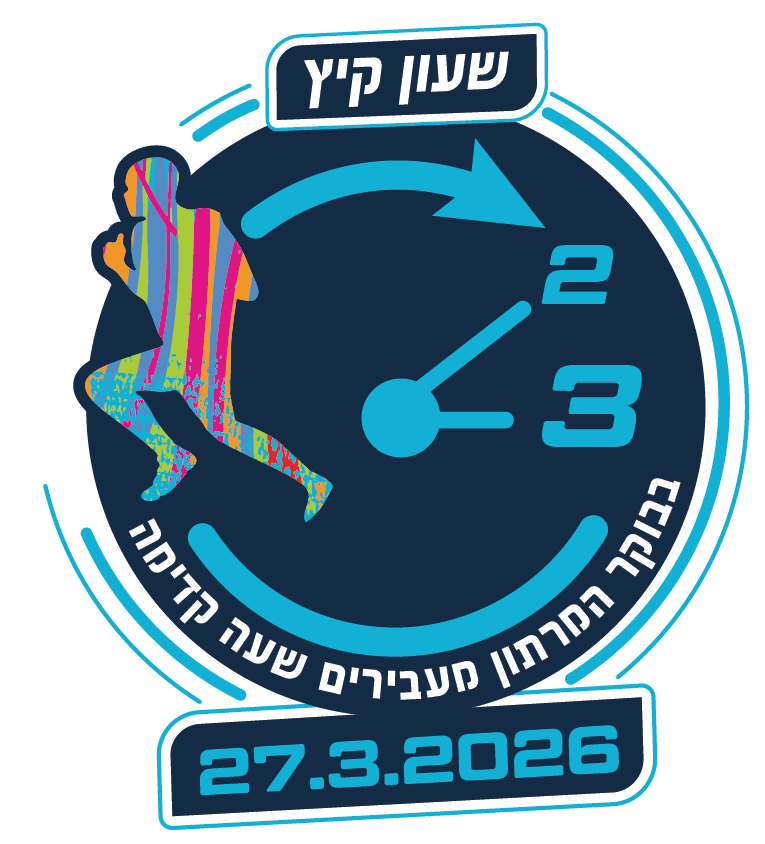The Jerusalem Winner Marathon, Israel's largest international running event, is quickly approaching and the number of trainees and their enthusiasm are growing just as fast. The months prior to the marathon are spent burning thousands of calories, losing fluids and recruiting the mental effort necessary to persist, improve performance, and prepare for an exciting, enjoyable athletic experience.
Running is a way of life for many runners and any kind of pain that they feel while they run immediately raises questions of whether the sensation is normal and how to prevent the next injury. Many risk factors are involved in all kinds of sports, and particularly running, including the quality of the track, weather conditions, and geography, to name only a few of the external risks that can be mediated by designated training programs, drinking plenty of fluids, and constantly remaining alert while running. Internal risk factors include agility, recovery rates, muscle strength and posture. Some of these factors are more significant than others, and researchers continue to debate the ultimate formula for avoiding injury.
This article will discuss the strength component, which has been shown to have a significant impact on improving performance and preventing injury. Weakness and lack of muscle balance can increase the chances of injury. The assumption is that the more we reduce rotational and frontal force (which work sideways) while running, a skill that occurs while advancing straight and forwards, the more we can reduce recurrence of injuries caused by overuse or increased repetitions during long runs. In the past, it was believed that the up-down strengthening strategy was more effective at reducing unwanted forces while running, but recent studies actually emphasize the importance of strengthening the body from the ankle and moving upwards.
Another assumption is that the more the pace increases, the more active the ankle muscles will be while running. It is important to note that the ankle, knee and thigh all absorb significant force upon impact with the ground and enable runners to push forward.
The purpose of this article is to discuss overuse injuries, namely those caused by increasing pressure combined with inadequate recovery techniques. In addition to a strengthening program, all beginning runners should schedule an orthopedic examination with a physical therapist that specializes in sports in order to try to identify potential risk factors. The most common injuries among runners include pain in the frontal part of the knee, ITB syndrome (inflammation of the lateral bands in the knee as a result of rubbing due to poor posture or to weaken knee control), various ankle injuries, and inflammation in the inguinal region and in the exterior of the knee.
An exercise program designed to strengthen the lower limbs is recommended in order to improve performance and prevent recurring injuries. Some begin these programs for marathon runners at the beginning of the running season, while others incorporate it at different times during the season, during the "down times" between races. My recommendation for short and medium-distance runners is to strengthen their lower limbs regularly, approximately twice per week before your shortest runs. Incorporate exercises that will strengthen the core muscles, which are part of the muscle structure that covers the hip bones and spine, in order to improve your running quality and avoid injury.
Below are several recommended exercises. They have been photographed at the Medix Center for Advanced Orthopedics, and are demonstrated by Anat Eyal, a trainer at Medix.
1. Lunges –Strengthen the front and back thigh and the buttocks:
Stand in lunge position with one leg in the front and one in the back, while keeping your back straight. Bend both knees as you lower your body in order to maintain a vertical line and keep your knee steady to prevent it from collapsing inwards.

2. Hip lifts – Strengthen the buttocks and rear thigh muscles:
Lay on your back with your knees bent. Place a fitball under your legs if you like. Contract the buttock muscles and lift your hips while exhaling. Relax your neck and use your hands for support.

3. Distance the thigh on one leg:
Stretch your torso and move your thigh sideways, stretching it against a band placed around your bent leg (hold your knee steady at all times).
4. Plank:
Static contractions of the abdomen while leaning on your arms, contracting your stomach muscles tightly to avoid collapsing onto your lower back. For a more advanced exercise, alternate leaning on your right and left arms.
5. Lifting heels while standing:
Place the front half of your foot on a step, lift your heels upwards and then allow them to sink deeply back downwards.
6. Standing on one foot on an unstable surface:
A mattress, dome ball, or other unstable surface with your knee bent. The knee should be faced slightly outwards and the hips should be horizontal to the ground. Stand still for 30-60 seconds, preferably with your eyes closed.
We recommend four sets of 15 repetitions of each exercise. Perform them slowly, and pay attention to your posture and breathing.
Most of the exercises can be performed outdoors, but the advantage of performing them in a gym is that you can gradually increase the burden and increase their impact. Your muscles should feel fatigued at the end of the series and eventually, when an exercise becomes too easy, you can increase the intensity by adding weights, bands or other accessories that offer greater resistance.
Wishing you a safe, enjoyable race!
Avichai Soroka – is a physical therapist that specializes in orthopedic and sports injuries at the Medix Center for Advanced Orthopedics. He is the accompanying physical therapist for the Israel Tennis Association and a PhD student involved in spinal research at Tel Aviv University.
Running is a way of life for many runners and any kind of pain that they feel while they run immediately raises questions of whether the sensation is normal and how to prevent the next injury. Many risk factors are involved in all kinds of sports, and particularly running, including the quality of the track, weather conditions, and geography, to name only a few of the external risks that can be mediated by designated training programs, drinking plenty of fluids, and constantly remaining alert while running. Internal risk factors include agility, recovery rates, muscle strength and posture. Some of these factors are more significant than others, and researchers continue to debate the ultimate formula for avoiding injury.
This article will discuss the strength component, which has been shown to have a significant impact on improving performance and preventing injury. Weakness and lack of muscle balance can increase the chances of injury. The assumption is that the more we reduce rotational and frontal force (which work sideways) while running, a skill that occurs while advancing straight and forwards, the more we can reduce recurrence of injuries caused by overuse or increased repetitions during long runs. In the past, it was believed that the up-down strengthening strategy was more effective at reducing unwanted forces while running, but recent studies actually emphasize the importance of strengthening the body from the ankle and moving upwards.
Another assumption is that the more the pace increases, the more active the ankle muscles will be while running. It is important to note that the ankle, knee and thigh all absorb significant force upon impact with the ground and enable runners to push forward.
The purpose of this article is to discuss overuse injuries, namely those caused by increasing pressure combined with inadequate recovery techniques. In addition to a strengthening program, all beginning runners should schedule an orthopedic examination with a physical therapist that specializes in sports in order to try to identify potential risk factors. The most common injuries among runners include pain in the frontal part of the knee, ITB syndrome (inflammation of the lateral bands in the knee as a result of rubbing due to poor posture or to weaken knee control), various ankle injuries, and inflammation in the inguinal region and in the exterior of the knee.
An exercise program designed to strengthen the lower limbs is recommended in order to improve performance and prevent recurring injuries. Some begin these programs for marathon runners at the beginning of the running season, while others incorporate it at different times during the season, during the "down times" between races. My recommendation for short and medium-distance runners is to strengthen their lower limbs regularly, approximately twice per week before your shortest runs. Incorporate exercises that will strengthen the core muscles, which are part of the muscle structure that covers the hip bones and spine, in order to improve your running quality and avoid injury.
Below are several recommended exercises. They have been photographed at the Medix Center for Advanced Orthopedics, and are demonstrated by Anat Eyal, a trainer at Medix.
1. Lunges –Strengthen the front and back thigh and the buttocks:
Stand in lunge position with one leg in the front and one in the back, while keeping your back straight. Bend both knees as you lower your body in order to maintain a vertical line and keep your knee steady to prevent it from collapsing inwards.

2. Hip lifts – Strengthen the buttocks and rear thigh muscles:
Lay on your back with your knees bent. Place a fitball under your legs if you like. Contract the buttock muscles and lift your hips while exhaling. Relax your neck and use your hands for support.

3. Distance the thigh on one leg:
Stretch your torso and move your thigh sideways, stretching it against a band placed around your bent leg (hold your knee steady at all times).
4. Plank:
Static contractions of the abdomen while leaning on your arms, contracting your stomach muscles tightly to avoid collapsing onto your lower back. For a more advanced exercise, alternate leaning on your right and left arms.
5. Lifting heels while standing:
Place the front half of your foot on a step, lift your heels upwards and then allow them to sink deeply back downwards.
6. Standing on one foot on an unstable surface:
A mattress, dome ball, or other unstable surface with your knee bent. The knee should be faced slightly outwards and the hips should be horizontal to the ground. Stand still for 30-60 seconds, preferably with your eyes closed.
We recommend four sets of 15 repetitions of each exercise. Perform them slowly, and pay attention to your posture and breathing.
Most of the exercises can be performed outdoors, but the advantage of performing them in a gym is that you can gradually increase the burden and increase their impact. Your muscles should feel fatigued at the end of the series and eventually, when an exercise becomes too easy, you can increase the intensity by adding weights, bands or other accessories that offer greater resistance.
Wishing you a safe, enjoyable race!
Avichai Soroka – is a physical therapist that specializes in orthopedic and sports injuries at the Medix Center for Advanced Orthopedics. He is the accompanying physical therapist for the Israel Tennis Association and a PhD student involved in spinal research at Tel Aviv University.








